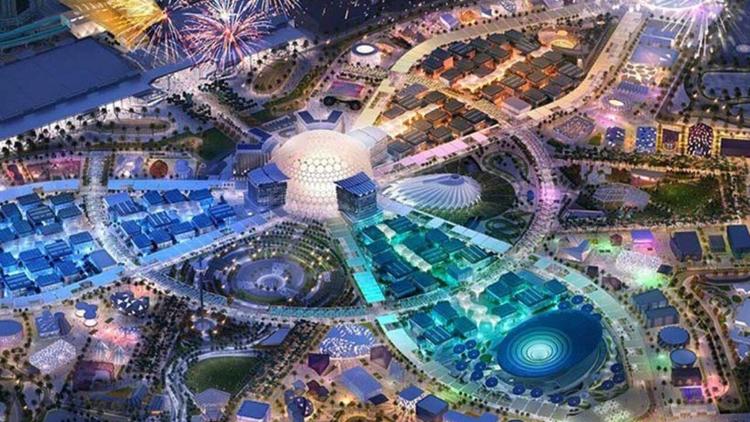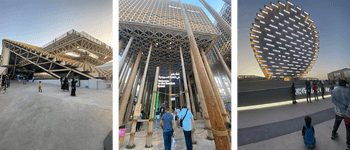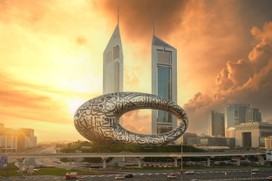For the last week, I’ve been out in Dubai exploring Expo 2020 — the current instantiation of the once great World’s Fairs. I’ve done a deeper dive below, but here’s a quick run-down of what I learned from my visit:
- There’s enormous demand for in-person mega-events. The Expo saw 24 million visitors from all over the world in just 6 months.
- The devil is in the details when it comes to execution. The food and architecture were huge highlights, but issues like wait times, lack of space to sit and relax, and communications difficulties took away from the guest experience.
- The Expo’s vision revolves around national branding. Unlike Disneyland or museums, the Expo didn’t feel like an immersive experience with stories or technologies. Instead, guests bounced between wildly different pavilions for individual nations, with little storytelling or design to make the entire experience feel cohesive and magical.
- Storytelling around the future is way more compelling. Dubai’s Museum of the Future, which I also visited, managed to deliver more hope in less space through immersive technologies and imaginative storytelling. We need to deliver these types of experiences at the scale of the Expo.
- We’re doing something completely different. Our vision for the World’s Fair is to showcase a cohesive, optimistic, and creative vision for the future. This type of narrative is what made great Fairs so magical, and is the key piece that the Expo is missing.
All of these lessons will be important as we design our World’s Fair. Rather than focusing on the structure of past World’s Fairs (which is what the Expo does), we’re working to recapture their spirit of excitement and hope for the future. That’s why it’s so important that we not only revive the fair, but reimagine its structure and design to make it relevant in our current era.
That said, the Expo was a lot of fun! There is something undeniably inspiring about the Expo as proof that we can still build (almost unbelievably) massive projects at breakneck speeds. The food, architecture, and sense of celebration made it an unforgettable experience. If you have the chance to go to an Expo (the next one is in Japan in 2025!), I’d recommend it.
Just don’t expect to leave the Expo with a renewed excitement in the future. But no worries — that’s what we’re here to build.
Onwards!
Cameron
The Deep(ish) Dive on the Expo
Let’s start with a quick primer so you have context.
Alright, a 2-minute history.
Countries around the world have hosted major expositions dating back to the mid-1800s. They debuted the steam engine, the telephone, the Model T and its assembly line, broadcast television, and touchscreens, all accelerating their mainstream adoption. They are responsible for symbols of progress that stand to this day, like the Eiffel Tower and Seattle’s Space Needle. They spread the ideas of some of history’s most influential people like Walt Disney, Amelia Earhart, Booker T. Washington, and Albert Einstein.
At their peak, there was a major exposition going about every other month around the world. This was causing a lot of problems and was getting expensive, so in 1928 a group known as the BIE (Bureau of International Expositions) formed to standardize the process of hosting an international exposition. Inspired by the Olympics, they get together to review bids from member nations and vote on who will host. When a country wins the bid, all of the other nations agree to attend and build pavilions.
While this centralization streamlined the hosting of these events, it also changed their very nature. Over the decades, the Fairs’ original role in celebrating grand achievements and ideas for the future morphed into an exercise in nation branding. This shift towards promoting national infrastructure projects, tourism, or economic investment opportunities meant that Fairs were no longer designed for a magical guest experience. This model serves important political purposes, but now we’re missing the cultural value that past great Fairs provided.
Enter Dubai
This year, Dubai became the latest country to host an Expo. As part of their national rebranding and the Sheik’s vision for Dubai, they spent big on their bid and were selected to host the 2020 Expo back in 2013. Over 7 years (plus a little bonus thanks to COVID), they turned 1,083 acres of desolate desert into a thriving business district that will ultimately become a small city. This Expo drew 24 million visits (about 12 million unique visitors). Not bad!
Takeaways
With the basics covered, we’ll jump into my experience at the expo. Again, my goal for the trip was to conduct market research, identify insights, and find inspiration for our Fair. While I have dozens of pages of notes, I wanted to share a few of the things that stood out.
Huge Demand
There’s something magical and intoxicating about large events. If you’ve been to a music festival, sports game, or even Disneyland, you know what I’m talking about. Being at the Expo gave me this feeling again, which everyone appeared to be craving after two years of COVID-cancellations.
On the days I was there, I was impressed by how many people showed up (~400k visits per day, with ~120k on site at any given time) and how diverse the crowd was. People of every age and nationality were there to have a good time. What’s more is that people were willing to wait hours to get into some of the pavilions. We’re talking 3+ hours for many of the pavilions — you would have thought we were at Disneyland trying to ride Space Mountain!
On the upside, I had plenty of time to talk with people in line. Some were there for the architecture, others for the food and shows, many simply for the spectacle that is the Expo. What stood out to me most was how much this event meant to the local schools. Talking with a teacher, I learned that the kids, many of whom have never left the UAE, loved seeing the other countries and learning about them. They were able to “see” the world in a day in a way that no amount of time reading books or looking at maps in the classroom would provide.
Incredible Food.
One of the most compelling parts of the expo was being able to eat around the world. You could eat a baguette in France, a stroopwafel in the Netherlands, and paella in Spain. Most countries were staffed by folks from that country and some, like New Zealand, went all out — everything from the wine to the chairs you sat in was sourced from New Zealand. It felt like stepping into that country for an hour and is certainly something to replicate.
Inspiring Architecture.
I’ve said before that these mega-events are mostly architecture competitions. Which, even though true, doesn’t mean they’re not awesome. I was blown away by some of the designs (Here’s a good roundup) and the detail put into them.
Historically, these events have served as grounds for experimentation with architecture and construction materials. I was hoping to see this, but unfortunately there wasn’t much 3D printing, mycelium, or new materials being deployed (or at least they weren’t talked about). That said, Sweden did construct their entire Pavilion from wood, which was quite neat!
Now, here’s where the magic started to fade. When you finally made it through the line (braving several hours in some cases) you start to realize that most of the budget was spent on looking pretty rather than creating great content for the guests.
Missing Story
The Expo works by leasing space to countries who show up, design, build, and operate their own pavilions (or outsource it). Countries hire an architect to design the outside because this is what people see, and then use whatever budget is left for the inside. Not only is the budget minimal, but it’s clear that there’s no owner for the content and that it’s designed to appeal to the political class rather than everyday people.
As someone who was looking forward to seeing how other countries are imagining the future, I was disappointed to find little beyond buzz-world laden promises of: “big data,” “smart cities,” “urban mobility,” “AI,” and the UN SDGs. But it wasn’t clear how any of these promises were actually being brought to life. The snappy videos and visuals felt more like a PR campaign for tourism and foreign investment than a real path towards building the future we want to see.
4a. Museum of The Future
Coming in with a bias, I was worried that I was a bit jaded. Were my expectations too high?
Fortunately, I was able to visit another experience in town — the Museum of The Future. Here, I realized that my expectations weren’t unreasonably high. The Expo simply wasn’t delivering on its potential.
The Museum of the Future is an incredible building full of the substance you would expect. Inside, you were taken on a journey into an imagined future: you visited a space station that was monitoring the health of the planet, a technology detox spa, and a library of all living creatures that were being genetically modified to adapt to a changing climate.
There was story, creative thinking, and meticulous attention to detail. The time I spent here felt like I was 10 years old again, exploring the Innovention Center at Disneyland. I was immersed in a possible future that I could see myself living in — a future that I wanted to see exist.
This is the power of story — if you want people to be excited about the future, you have to provide something concrete. Closing the gap between reality and possibility is what makes this experience so compelling, and what we’re designing for at the Fair.





